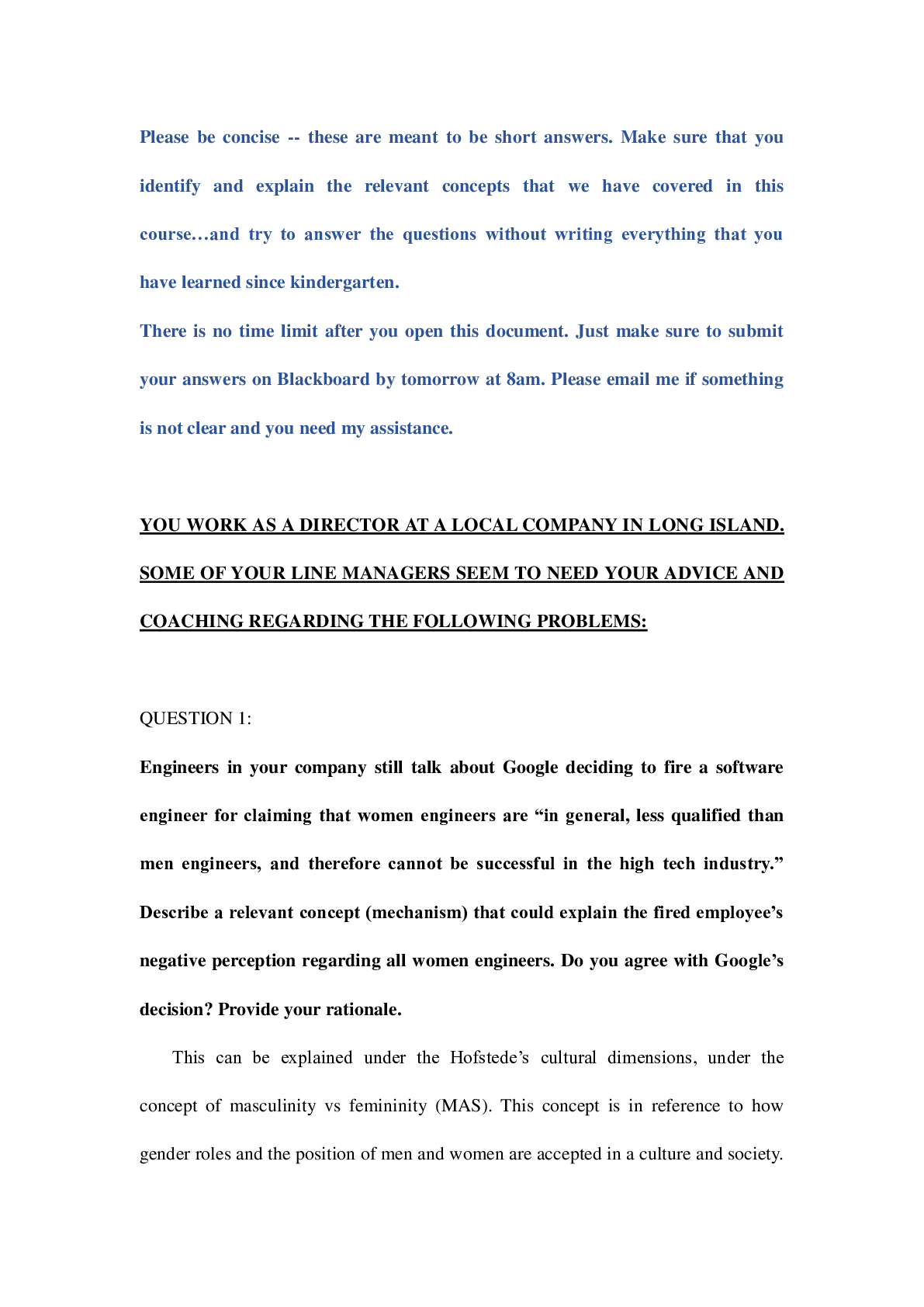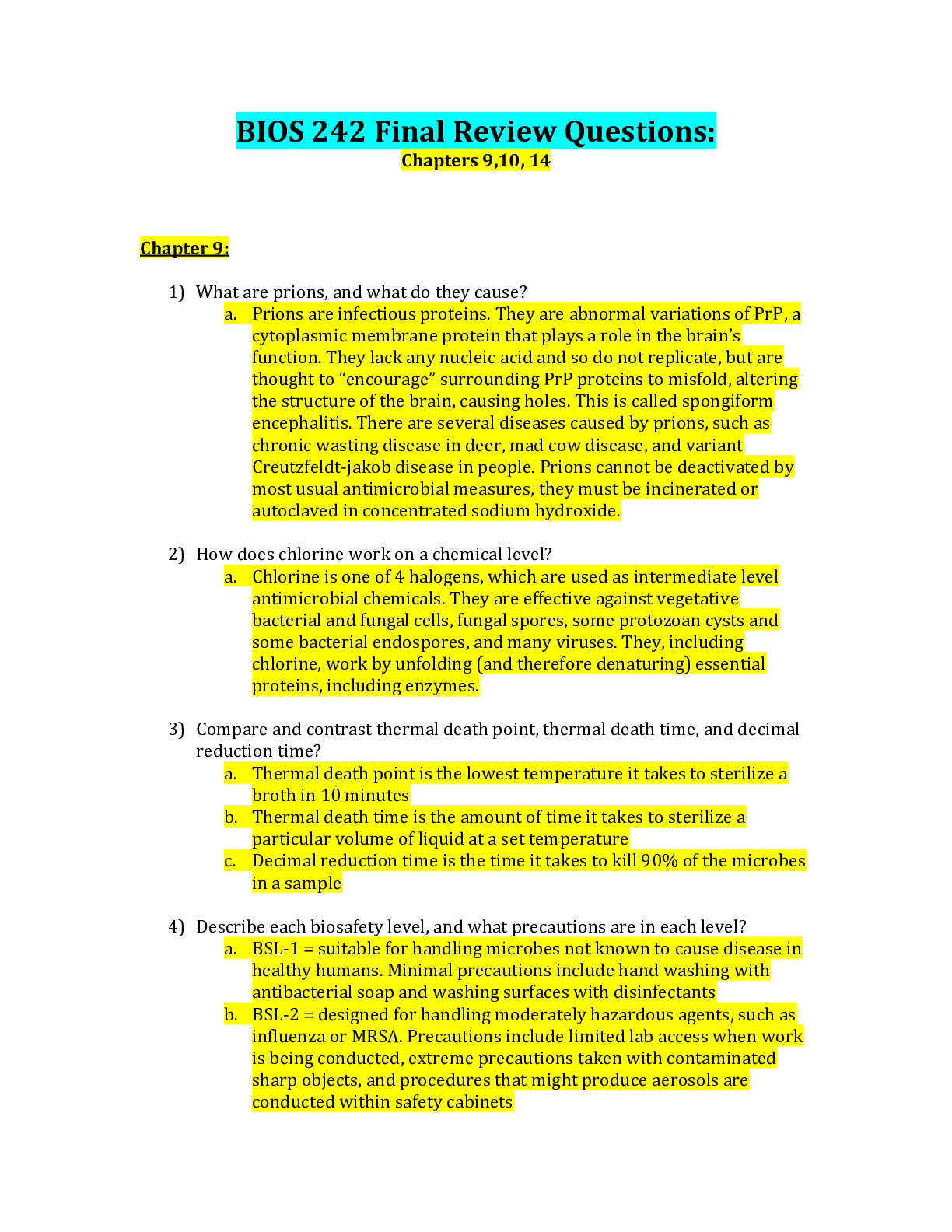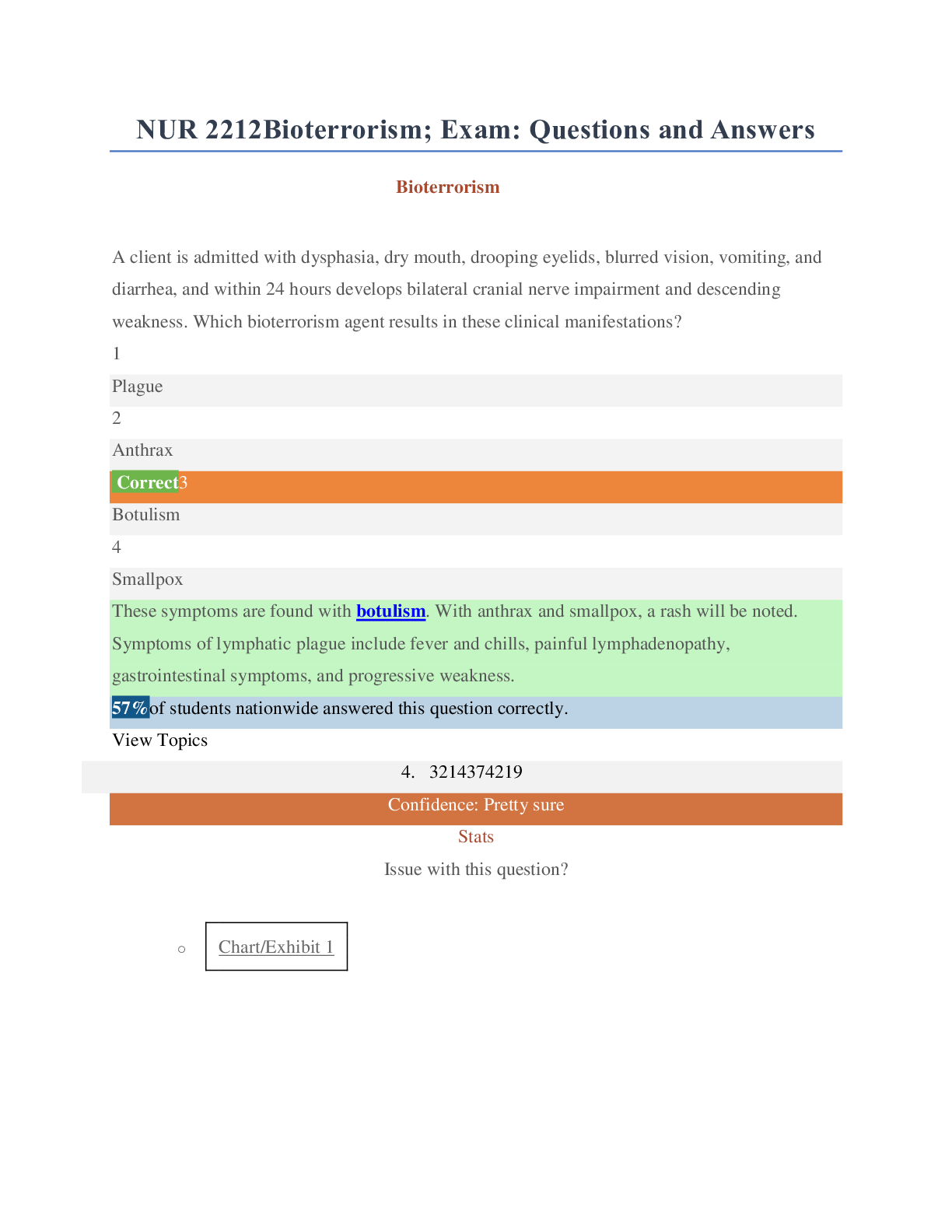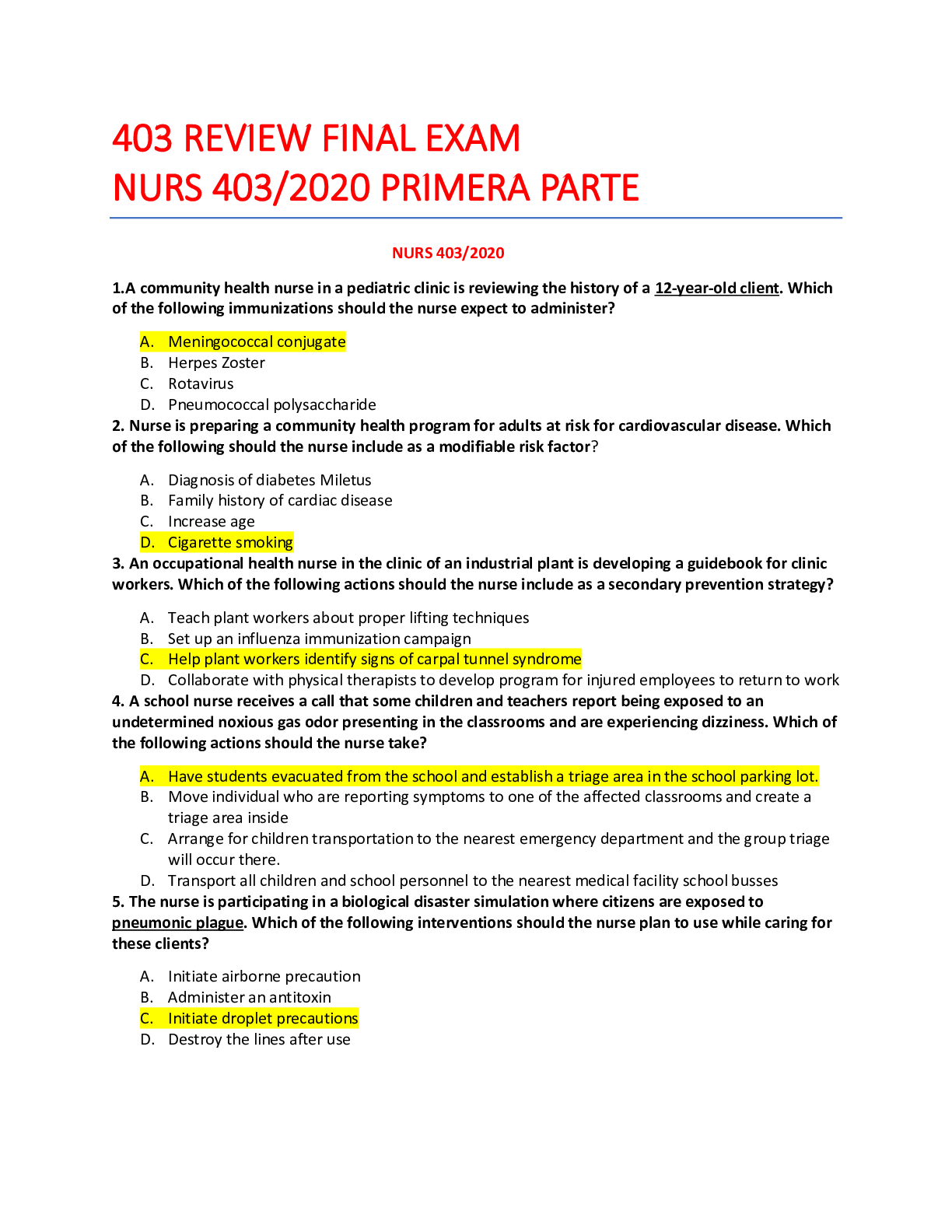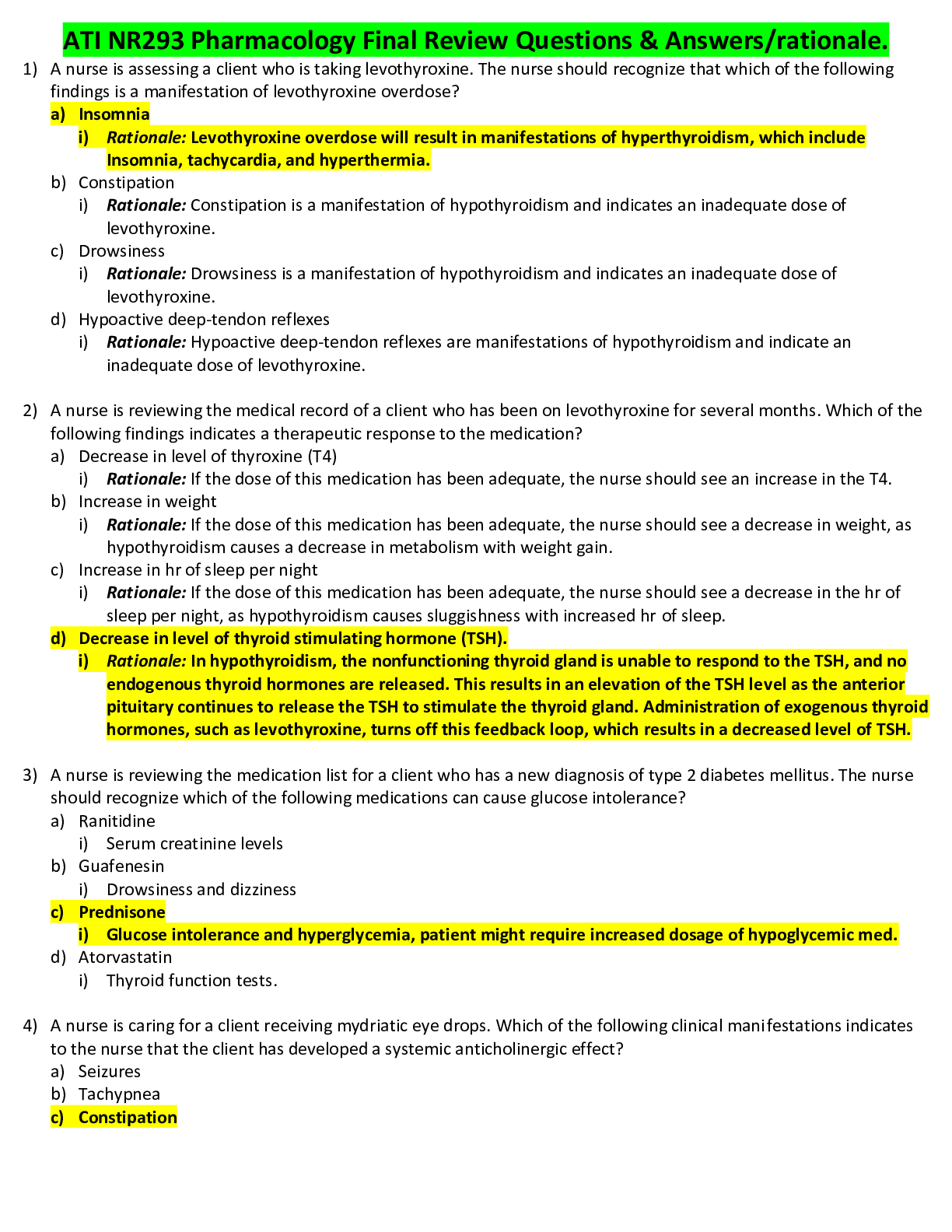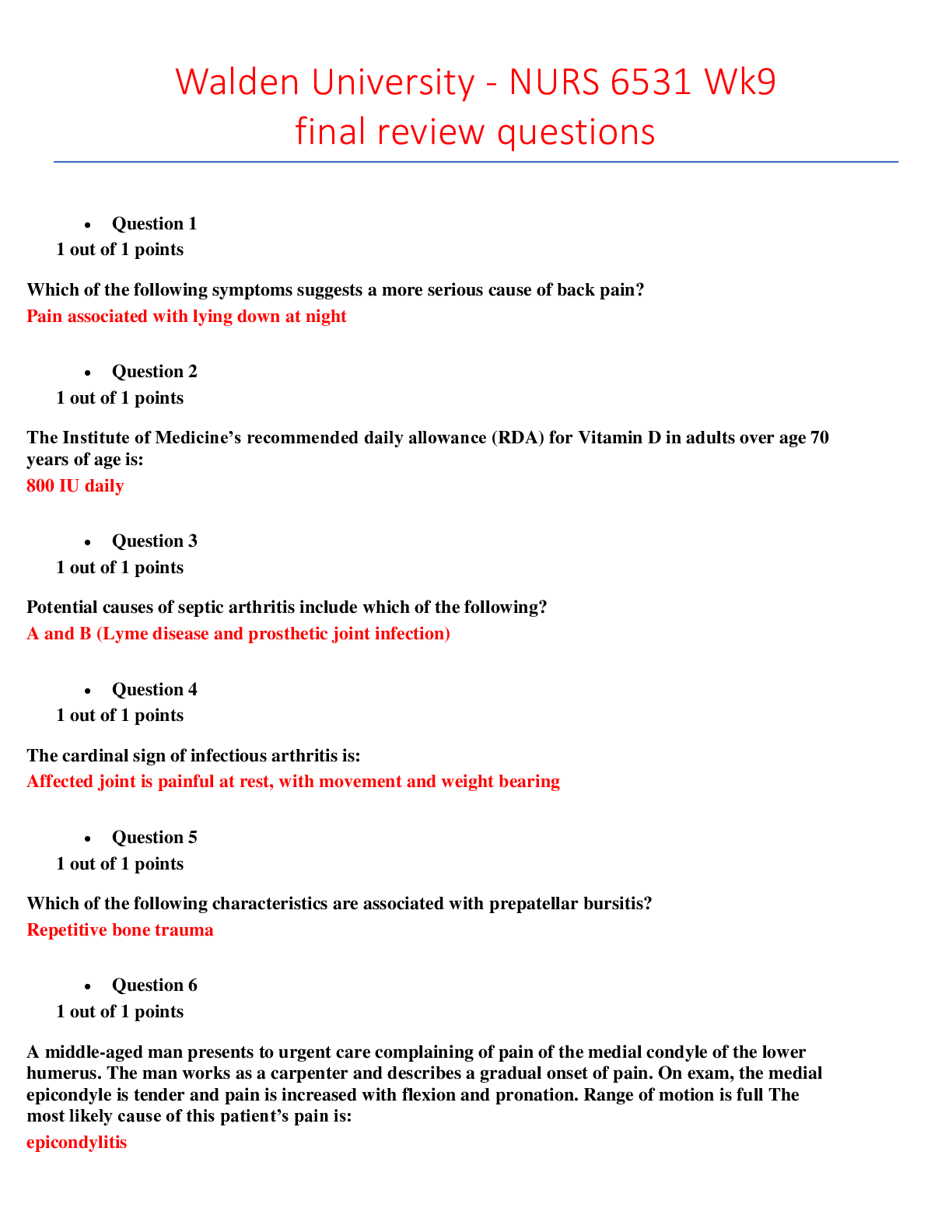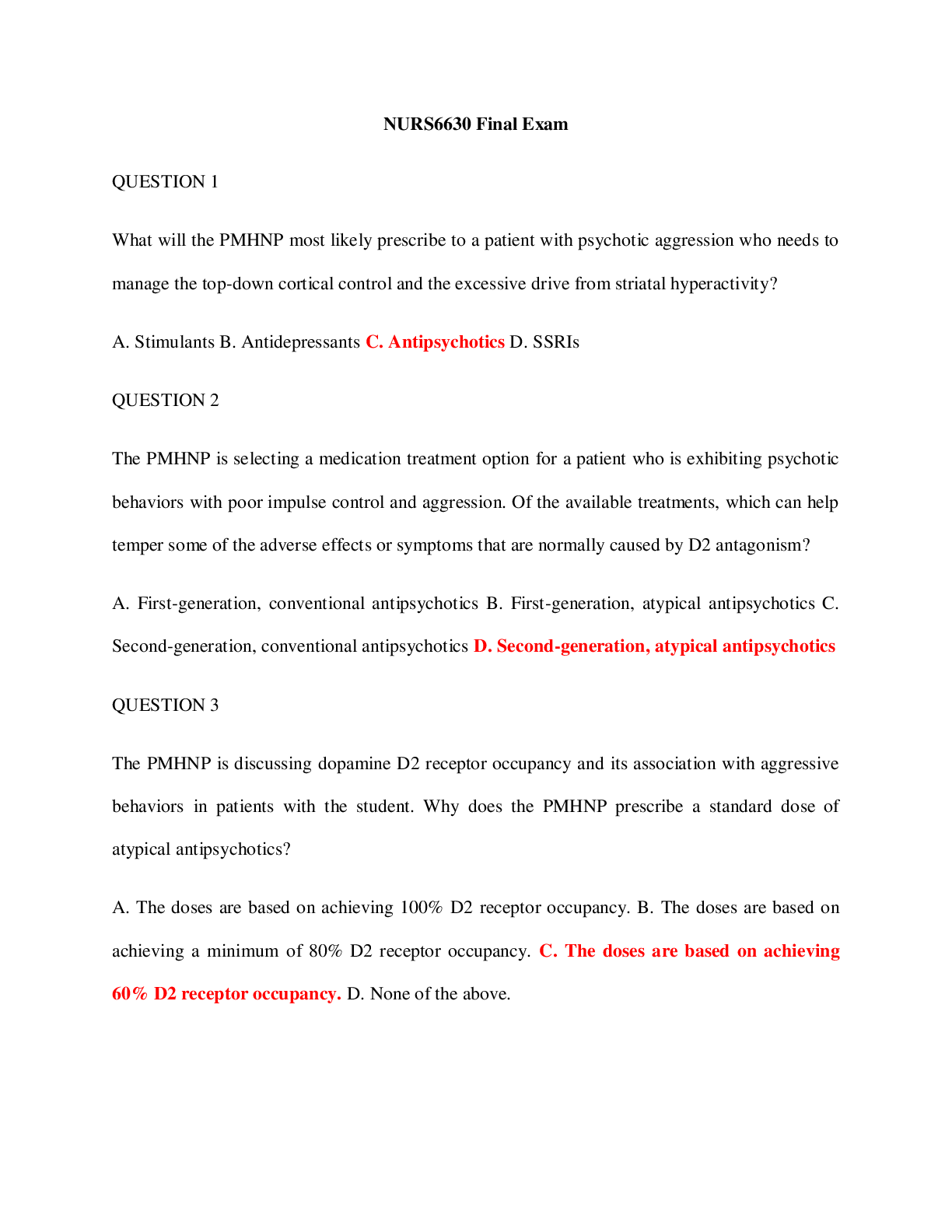Emergency Medicine > QUESTIONS & ANSWERS > OSHA 10 Final Review Questions And answers. Graded A+. 100% Approved Pass Rate (All)
OSHA 10 Final Review Questions And answers. Graded A+. 100% Approved Pass Rate
Document Content and Description Below
1. Approximately 75 percent of struck-by fatalities involve: - Ans-Heavy equipment, such as trucks or cranes (Your Answer) 1. Before the start of each work shift, it is mandatory that: - Ans-A comp... etent person inspects the scaffold before the start of each work shift (Your Answer) 1. In the case of materials handling, storage, use and disposal, remember that the main hazards are injuries from: - Ans-Improper lifting and carrying Being struck by materials or caught in pinch points Being crushed by improperly stored material 1. OSHA defines a trench as: - Ans-A narrow excavation made below the surface of the ground in which the depth is greater than the width - with the width not to exceed 15 feet (Your Answer) 1. OSHA's Hazard Communication Standard (HazCom) is designed to ensure that information about __________and associated protective measures is disseminated. - Ans-Hazardous chemicals (Your Answer) 1. The four main causes of crane accidents are contact with power lines, overturns, falls and mechanical failure. Two other errors mentioned in this module that often lead to trouble are: - Ans-Improper maintenance and failure to conduct regular inspections 1. The greatest hazards posed by hand tools result from: - Ans-Misuse and improper maintenance (Your Answer) 1. The two steps for avoiding hazards that are always taken before the need for PPE is considered are: - Ans-Work practice and engineering controls (Your Answer) 2. A training program to teach proper lifting techniques should cover: - Ans-Knowledge of the basic anatomy of the spine, muscles, and joints of the trunk The use of safe lifting postures and timing 2. Chemical manufacturers and importers must convey the hazard information they learn from their evaluations to downstream employers by means of labels on containers and: - Ans-Safety Data Sheets (SDSs) (Your Answer) 2. If the use of a power tool can result in flying sparks, metal shavings, wood chips, splashes, or other debris, workers should: - Ans-Protect themselves by wearing the proper PPE (Your Answer) 2. It is preferable not to drive a vehicle in reverse if you have an obstructed rear view, but if you do, make sure: - Ans-The vehicle has an audible reverse alarm (Your Answer) 2. No modifications or additions that affect the capacity or safe operation of a crane or derrick should ever be made without: - Ans-The manufacturer's written approval, which should be kept on file (Your Answer) 2. OSHA defines an excavation as: - Ans-Any man-made cavity, depression, trench or cut in the earth's surface formed by earth removal 2. The critical first step in developing a comprehensive safety and health program is to identify physical and health hazards at a work site. This process is known as: - Ans-A Hazard Assessment (Your Answer) 2. The first step in building a scaffold is to: - Ans-Conduct a site inspection (Your Answer) 3. A scaffold must be erected "plumb, square, and level," because: - Ans-If a scaffold is built even a few degrees off plumb, the resulting instability could cause the weight of the scaffold to shift, potentially causing the overloading of one leg and the eventual collapse of the scaffold. (Your Answer) 3. Because the number of injuries from operating powered industrial trucks was on the rise, the OSHA standard for Powered Industrial Trucks was revised March 1, 1999. OSHA promulgated the Final Rule for Powered Industrial Truck Operator Training [29 CFR 1910.178(1)], which: - Ans-Requires operator training and licensing as well as periodic evaluations of operator performance Requires operators to take and pass a written and road test (similar to a driver's education) before they can operate the forklift. 3. OSHA requires that many categories of PPE meet or be equivalent to standards developed by: - Ans-The American National Standards Institute (ANSI) (Your Answer) 3. Power tools should never be carried by the cord or hose or be yanked from a receptacle by the cord or hose; and cords and hoses should be kept away from: - Ans-Heat, oil and sharp edges (Your Answer) 3. Truck-mounted and rough terrain cranes are both forms of a mobile crane, and both use which of the following to increase their stability? - Ans-Outriggers 3. True or False: There is usually some form of warning before a cave-in. - Ans-False 3. Under the new HAZCOM/GHS requirements for Safety Data Sheets (SDS's) they must now have 16 total Sections. - Ans-True (Your Answer) 3. Workers are most at risk from falling objects when standing or working: - Ans-Under scaffolds Under cranes Wherever overhead work is being performed 4. Employers must provide employees with effective information and training on hazardous chemicals in their work area: - Ans-At the time of their initial assignment Whenever a new hazardous chemical is introduced into their work area 4. Operators must complete three separate aspects of powered industrial truck training: formal training, practice training, and: - Ans-Evaluation 4. OSHA 1926.454(c) states: When an employer has reason to believe that an employee lacks the skill or understanding needed for safe work involving the erection, use or dismantling of scaffolds, the employer shall: - Ans-Retrain each such employee so that the requisite proficiency is regained (Your Answer) 4. OSHA requires that all excavations in which employees could potentially be exposed to cave-ins be protected by one or more of the following three methods: - Ans-Sloping, benching, shoring and shielding (Your Answer) 4. Rated load capacities, recommended operating speeds, and special hazard warnings or instructions must be: - Ans-Conspicuously posted on the crane, where the crane operator can see them while he is at his control station (Your Answer) 4. Sharp, abrasive, pinching, or otherwise hazardous moving parts of power tools: - Ans-Must have guards to prevent contact with workers (Your Answer) 4. To prevent injury from flying debris, use safety glasses, goggles, face shields, etc., where machines or tools may cause flying particles; and always inspect tools, such as saws and lathes, to ensure that: - Ans-The protective guards are in good condition and firmly attached 4. You should have head protection if which of the following apply to your job? - Ans-Objects might fall from above There are low-hanging pipes or beams There are exposed electrical hazards 5. Before an abrasive wheel is mounted, it should be inspected closely and: - Ans-Sound- or ring-tested to ensure that it is free from cracks or defects (Your Answer) 5. Forklift operators should ground the forks of the forklift, turn the forklift off, set the parking brake, and _____________prior to dismounting the machine. - Ans-Neutralize the controls 5. In general, head protection should do which of the following? - Ans-Resist penetration by objects and absorb the shock of a blow Be water-resistant and slow burning Have clear instructions explaining proper adjustment and replacement of the suspension and headband 5. The formula for all simple slope excavations 20 feet (6.11 meters) or less deep states that for every foot of depth, the trench must be excavated back: - Ans-1 and ½ feet (Your Answer) 5. The four lifting principles that govern a crane's mobility and safety during lifting operations are: - Ans-Center of gravity, leverage, stability and structural integrity (Your Answer) 5. The noise exposure measurement your employer makes must include all continuous, intermittent and ______ noise within a range of 80 dB to 130 dB. - Ans-Impulsive 5. To adhere to fire safety precautions, flammable and combustible materials must be stored according to: - Ans-Their fire characteristics 5. When dismantling a scaffold, all work should be conducted: - Ans-From the top down (Your Answer) 6. Employees working in the vicinity of a crane must take care to avoid what kind of accident? - Ans-"Struck by" (Your Answer) 6. General safety principles that can help reduce workplace accidents include: - Ans-Work practices Ergonomic principles Training and education 6. If a machine has an exposed pulley and conveyor but the portion of it that is exposed is well underneath the machine, the employer: - Ans-Must ensure that all that all exposed and accessible sections of the machine are guarded (Your Answer) 6. Neither the operator nor anyone else should ever stand directly in front of the wheel of an abrasive power tool as it accelerates to full operating speed. Why? - Ans-Because there is always the chance that the wheel wasn't sound and could disintegrate or explode 6. The three main scaffold types are aerial lifts, supported scaffolds and: - Ans-Suspended scaffolds (Your Answer) [Show More]
Last updated: 1 year ago
Preview 1 out of 15 pages
Instant download

Buy this document to get the full access instantly
Instant Download Access after purchase
Add to cartInstant download
Reviews( 0 )
Document information
Connected school, study & course
About the document
Uploaded On
Jun 10, 2022
Number of pages
15
Written in
Additional information
This document has been written for:
Uploaded
Jun 10, 2022
Downloads
0
Views
188















